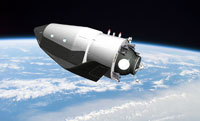Russian Space Tech Surges Forward
With the next to the last flight of the American space shuttle in the air, the US will soon be retiring their space shuttles to replace them with a new vehicle, scheduled for 2013. Of course, seeing how things always delay in America, it is more likely 2023 is a better year. Until then, the Americans will be riding on Russian Soyuz capsules . But the Soyuz itself, a 40 year old technology with many modernizations, is on its way out, to be replaced with bigger better platforms.

The replacement of the Soyuz will be the Kliper, a ship carrying 6 crew and a half ton of cargo. It is scheduled to fly its maiden voyage some time in 2010. The ship is about twice the size of the Soyuz and will require much larger rockets, most likely the Zenit class of booster rockets, in order to make orbit. It will return to earth by extending wings and gliding down, for a soft landing.
Interestingly enough, if things go according to plant, the new, larger Kliper, will actually save money. The present Soyuz missions run between $20 to $30 million each (compared to the American space shuttles at around $300 million each). Kliper flights are supposed to move more equipment and people for less money, but even it the costs stay the same, with more room on the ship, there will be room for more space tourists and at $20 million per pop, the ships will earn a profit, with just one added passenger.
Development of the Kliper is also priced at the low cost of $1 billion, compare that to the $10 billion for the American Crew Exploration Vehicle (CEV), which is still on the drawing board.
But the Kliper is only the first modern step in a new plan by the Russian space agency to conquer the inner sphere of our solar system. Next on the development board is a manned spacecraft powered by a nuclear electric engine. Russia and the Soviet Union before, had developed, for decades, nuclear powered satellites, which did not have to rely upon easily damaged solar arrays, for power. Of course those put out only kilowatts of power, while this ships engines will have to run on the megawatt range. Of course, after40 years of working on this technology, this is a very realistic capability.
The ship's design is scheduled to be complete by 2012 and a finished by 2021, at an estimated cost of 17 billion rubles, or $580 million. More realistic estimates put the price tag at $1 to $1.5 billion, over the next decade.
The ship is aimed at flights to the Moon and to Mars, with a trip estimated to take about 39 days, one way. Nuclear electric rockets are twice as efficient as chemical rockets and most importantly, carry only a fraction of the weight in fuel. The Head of the Russian Space Agency, Anatoly Perminov was quoted as saying: "The project is aimed at implementing large scale space exploration programs, including manned missions to Mars, interplanetary travel, the creation and operation of planetary outposts."
True, the space budget is below these requirements, but there have been moves from President Medvedev down to the Duma to find funding and to find partners. If the Germans or Japanese can be brought into these projects, there is no end to the possibilities. NASA astronauts may be riding in Russian ships into the very far future, especially when counting how bankrupt the Americans are.
Stanislav Mishin
Mat Rodina
Subscribe to Pravda.Ru Telegram channel, Facebook, RSS!





